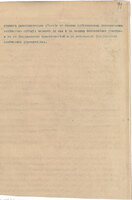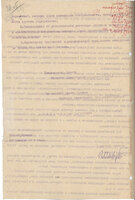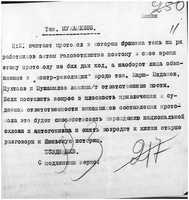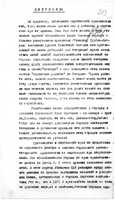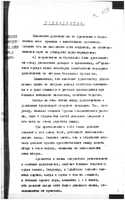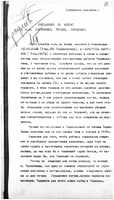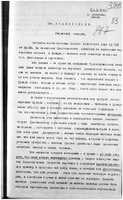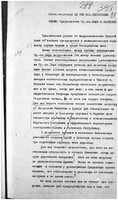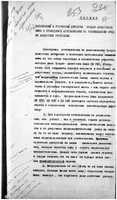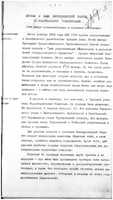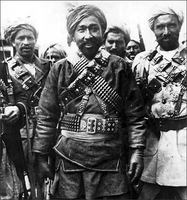Browse Documents (8724 total)
Date: 1950-07-28
Source: GARF,f.R6991,op.3,d.361,l.62-63
Date: 1950-07-21
Source: GARF,f.R6991,op.3,d.361,l.61
Transcription
Date: 1950-06-16
Source: GARF,f.R6991,op.3,d.361,l.58-59
Transcription
Date: 1950-06-10
Source: GARF,f.R6991,op.3,d.361,l.57
Transcription
Date: 1950-02-14
Source: GARF,f.R6991,op.3,d.361,l.42-45
Transcription
Date: 1950-01-26
Source: GARF,f.R6991,op.3,d.361,l.38-40
Transcription
Date: 1949-10-15
Source: GARF,f.R6991,op.3,d.361,l.30-31
Transcription
Date: 1949-07-18
Source: GARF,f.R6991,op.3,d.361,l.24-26
Transcription
Date: 1949-04-23
Source: GARF,f.R6991,op.3,d.361,l.17-20
Transcription
Date: 1948-12-31
Source: GARF,f.R6991,op.3,d.361,l.12-13
Transcription
Date: 1949-01-21
Source: GARF,f.R6991,op.3,d.361,l.1-3
Transcription
Date: 1948-12-1
Source: GARF,f.R6991,op.3,d.360,l.68-70
Transcription
Date: 1948-11-15
Source: GARF,f.R6991,op.3,d.360,l.66
Transcription
Date: 1948-08-27
Source: GARF,f.R6991,op.3,d.360,l.59
Transcription
Date: 1948-07-15
Source: GARF,f.R6991,op.3,d.360,l.55
Transcription
Date: 1948-03-14
Source: GARF,f.R6991,op.3,d.360,l.46
Transcription
Date: 1947-11-26
Source: GARF,f.R6991,op.3,d.360,l.35
Transcription
Date: 1947-09-30
Source: GARF,f.R6991,op.3,d.360,l.31
Transcription
Date: 1947-04-1
Source: GARF,f.R6991,op.3,d.360,l.22-25
Transcription
Date: 1947-01-16
Source: GARF,f.R6991,op.3,d.360,l.18-18ob,19ob
Transcription
Date: 1946-04-8
Source: GARF,f.R6991,op.3,d.360,l.5-6
Transcription
Date: 1989-02-20
Source: GARF,f.R6991,op.6,d.3887,l.57-63
Transcription
Date: 1983
Source: GARF,f.R6991,op.6,d.2636,l.55-58
Transcription
Date: 1983-03-01
Source: GARF,f.R6991,op.6,d.2636,l.37,41-42
Transcription
Date: n/d
Source: GARF,f.R6991,op.6,d.2635,l.4
Transcription
Date: 1983-02-14
Source: GARF,f.R6991,op.6,d.2534,l.5-9
Transcription
Date: 1983-02-12
Source: GARF,f.R6991,op.6,d.2534,l.2
Transcription
Date: 1983-01-31
Source: GARF,f.R6991,op.6,d.2534,l.1
Transcription
Date: 1930
Source: GARF,f.5143,op.1,d.712,l.121-129
Transcription
Date: 1930
Source: GARF,f.5143,op.1,d.712,l.89-120
Date: 1918-01-12
Source: GARF,f.R-1235,op.2,d.9,l.70-71
Date: 1919-12-26
Source: GARF,f.R-130,op.2,d.1,l.38-40
A brief, undated memo, of interest primarily for its language, on the squabbling among local communists. Is this the earliest use of “throwing shade”?
Date: n/d
Source: RGASPI,f.62,op.1,d.22,l.11
In this undated OGPU report (probably from 1927) the agents express their fears that the Ufa Central Spiritual Administration (Tsentral’noe Dukhovnoe Upravlenie) was extending its influence into Kyrgyz and Turkmen areas. Tatar imams organized spiritual administrations in the area. The Ufa administration is accused of “organizing group religious instruction,” among other things. The Ufa administration had not been as successful in the Turkmen SSR. Nonetheless, the OGPU felt that conditions in the republic were favorable for it. The report describes Turkmen clergy as “feudal-clan bosses,” who wielded influence over the mosque-based clergy and Communist Party officials. The proof was that four ishans in Merv Okrug had come out of the land reform campaign with more land than they had held before it started. The report should be interpreted more as an expression of OGPU paranoia than of the actual reach of the Ufa Spiritual Administration
Date: after 1926
Source: RGASPI,f.62,op.1,d.221,l.213-218
This is a long Sredazburo report dated early February, 1929, on the state of the clergy and Sufi ishans in the new Tajik SSR. The clergy’s position had become difficult, especially economically. Peasants were increasingly reluctant to pay clerical fees, sometimes hiring and firing several imams per year in search of the cheapest one. This increased tensions; clergy were known to beat their fees out of people. Later sections of the report discuss the many clergy earning fees as healers, tending livestock, and being supported by local farmers. Some clergy benefited from the practice of khudoi (sacrifice)—a desperate man would vow to give his son or daughter to the mulla if his dire situation was relieved. The investigators found that “several clerical individuals in Tajikistan have 2–3 ‘sons’ or ‘daughters’ who were given to them, who carry out all the farmwork for these individuals.” While some ishans wielded wide influence, the numbers of their followers had dwindled. Many villages had lost their mosques and thus positions for imams. Some had quit being imams and more fled to India and Afghanistan. Other clergy resisted with countereducation and anti-Soviet agitation. In several cases former clergy served on village soviets. One mulla headed the local peasant union Koshchi and collected “dues” from every individual and dues for two people from pregnant women. Muslim schools and courts operated in areas where there were no Soviet equivalents, and waqfs still existed. The document includes accounts of apocalyptic hysteria: in villages in the Kuliab region thousands of people were gripped by “madness,” refusing to eat, work in the fields, or engage in “personal life” because they believed that the world was about to end. Arresting the ringleaders stopped the outbreak
Date: 1929-02
Source: RGASPI,f.62,op.1,d.552,l.159-184
This December 10 (?), 1928 secret report from Alekseevskii and OGPU agent D’iakov to Sredazbiuro TsK VKP(b) chair Isaac Zelenskii, Gikalo, and the head of the Central Asian OGPU Lev Bel’skii concerns border security problems in the nascent Tajik Soviet Socialist Republic. Chair of the Tajik Soviet Narodnykh Kommissarov (Sovnarkom, the state side of the government) Abdurakhim Khojibaev and Chair of the Tajik Central Executive Committee (TsIK) Nasratulla Maksum think that the OGPU does not understand the border situation, where basmachi fighters and other “criminal elements” enter the USSR without fear of being shot. They want more Tajiks to be engaged in border protection, especially from the Khojent region. Alekseevskii and Diakov went to the border themselves and found that security organs’ work was “not bad,” but local Red Army soldiers were stealing from the populace. There’s a big smuggling problem, however, presided over by a wealthy bai. The OGPU agents have some ideas for action, but clearly do not trust Maksum. See also Botakoz Kassymbekova, Despite Cultures: Early Soviet Rule in Tajikistan (Pittsburgh: University of Pittsburgh Press, 2016)
Date: 1928-12-30
Source: RGASPI,f.62,op.1,d.552,l.78-81
This September 7, 1924 protocol of a meeting of the Central Asian Bureau outlines in detail the borders of the new Turkmen Soviet Socialist Republic. They were not yet making final decisions on everything; in some areas the populations were so mixed further study was needed. Uzbek and Turkmen communists were arguing fiercely over a number of areas that both groups claimed. A Tajik Autonomous Oblast’ was being carved out of the former Eastern Bukhara, and there were also border disputes between Turkmen and Tajiks
Date: 1924-09-07
Source: RGASPI,f.62,op.1,d.22,l.84-91
The Soviet definition of nations required that a clearly-defined people should live in a clearly-defined territory. Unfortunately, the different ethnic populations of Central Asia lived inter-mixed with each other. In the northern part of today’s Uzbekistan Uzbeks, Kazakhs, and Tajiks had lived together for centuries. The act of creating an Uzbek-majority republic in this territory would strand a large community of Kazakhs, who would suddenly find themselves a minority in a land they considered theirs. In this personal note dated August 25, 1924 from O. Ia. Karklin, deputy chair of the Central Asian Bureau of the Central Committee of the All-Russian Communist party(bolshevik), reports that the 270,000 “Kirgiz” (Kazakhs) of the Bukharan Soviet Peoples Republic are demanding their own autonomous area within the new Uzbek Soviet Socialist Republic. He recommends studying the issue.
Date: 1924-08-25
Source: RGASPI,f.62,op.1,d.22,l.83
Angry notes about mistreatment of Kygyz party members after the delimitaiton, and on how to convince Central Asians of the correctness of the delimitaiton.
Date: [1925]
Source: RGASPI,f.62,op.1,d.22,l.81-82
Date: [1924]
Source: RGASPI,f.62,op.1,d.22,l.47-50
Summary of borders and new economic resources in the new SSRs of Uzbekistan and Turkmenistan
Date: 1925-03
Source: RGASPI,f.62,op.1,d.34,l.3-31
Date: 1988-03-5
Source: GARF,f.R6991,op.6,d.3580,l.167
Transcription
Date: 1988-05-16
Source: GARF,f.R6991,op.6,d.3580,l.10-14
Transcription
Date: 1983-09-13
Source: GARF,f.R6991,op.6,d.2494,l.91
Transcription
Date: 1979-03-6
Source: GARF,f.R6991,op.6,d.1530,l.2-6
Transcription
Date: 1978-
Source: GARF,f.R6991,op.6,d.1324,l.52-56
Transcription
Date: 1978-
Source: GARF,f.R6991,op.6,d.1324,l.48-51
Transcription
Date: 1983-09-28
Source: GARF,f.R6991,op.6,d.4692,l.299-300
Transcription
Date: 1983-09-22
Source: GARF,f.R6991,op.6,d.4692,l.293-296
Transcription
Date: 1983-07-25
Source: GARF,f.R6991,op.6,d.4692,l.288-290
Transcription
Date: 1983-07-28
Source: GARF,f.R6991,op.6,d.4692,l.280-285
Transcription
Date: 1983-07-27
Source: GARF,f.R6991,op.6,d.4692,l.276-277
Transcription
Date: 1983-07-28
Source: GARF,f.R6991,op.6,d.4692,l.260-264
Transcription
Date: 1983-09-30
Source: GARF,f.R6991,op.6,d.4692,l.248-251
Transcription
Date: 1983-09-29
Source: GARF,f.R6991,op.6,d.4692,l.243-245
Transcription
Date: 1983-08-2
Source: GARF,f.R6991,op.6,d.4692,l.238-240
Transcription
Date: 1983-09-23
Source: GARF,f.R6991,op.6,d.4692,l.232-235
Transcription
Date: 1983-07-21
Source: GARF,f.R6991,op.6,d.4692,l.226-229
Transcription
Date: 1983-10-05
Source: GARF,f.R6991,op.6,d.4692,l.222-223
Transcription
Date: 1983-07-26
Source: GARF,f.R6991,op.6,d.4692,l.218-220
Transcription
Date: 1983-08-15
Source: GARF,f.R6991,op.6,d.4692,l.215-217
Transcription
Date: 1983-10-5
Source: GARF,f.R6991,op.6,d.4692,l.203-204
Transcription
Date: 1983-07-29
Source: GARF,f.R6991,op.6,d.4692,l.198-201
Transcription
Date: 1983-08-31
Source: GARF,f.R6991,op.6,d.4692,l.195-197
Transcription
Date: 1984-09-27
Source: GARF,f.R6991,op.6,d.4692,l.192-193
Transcription
Date: 1983-08-23
Source: GARF,f.R6991,op.6,d.4692,l.185-189
Transcription
Date: 1983-12-16
Source: GARF,f.R6991,op.6,d.4692,l.181-182
Transcription
Date: 1983-07-22
Source: GARF,f.R6991,op.6,d.4692,l.175-179
Transcription
Date: 1983-09-5
Source: GARF,f.R6991,op.6,d.4692,l.166-170
Transcription
Date: 1983-07-16
Source: GARF,f.R6991,op.6,d.4692,l.163-164
Transcription
Date: 1983-10-1
Source: GARF,f.R6991,op.6,d.4692,l.159-161
Transcription
Date: 1983-08-25
Source: GARF,f.R6991,op.6,d.4692,l.155-157
Transcription
Date: 1983-10-13
Source: GARF,f.R6991,op.6,d.4692,l.152-154
Transcription
Date: 1983-09-29
Source: GARF,f.R6991,op.6,d.4692,l.148-151
Transcription
Date: 1983-09-5
Source: GARF,f.R6991,op.6,d.4692,l.142-144
Transcription
Date: 1983-09-27
Source: GARF,f.R6991,op.6,d.4692,l.137-140
Transcription
Date: 1983-07-26
Source: GARF,f.R6991,op.6,d.4692,l.131-135
Transcription
Date: 1983-09-28
Source: GARF,f.R6991,op.6,d.4692,l.127-129
Transcription
Date: 1983-07-25
Source: GARF,f.R6991,op.6,d.4692,l.122-125
Transcription
Date: 1983-10-6
Source: GARF,f.R6991,op.6,d.4692,l.112-117
Transcription
Date: 1983-09-29
Source: GARF,f.R6991,op.6,d.4692,l.108-110
Transcription
Date: 1983-07-19
Source: GARF,f.R6991,op.6,d.4692,l.105-107
Transcription
Date: 1983-11-4
Source: GARF,f.R6991,op.6,d.4692,l.102-104
Transcription
Date: 1983-10-24
Source: GARF,f.R6991,op.6,d.4692,l.96-101
Transcription
Date: 1983-08-12
Source: GARF,f.R6991,op.6,d.4692,l.95,17-22
Transcription
Date: 1983-07-29
Source: GARF,f.R6991,op.6,d.4692,l.86-93
Transcription
Date: 1983-10-11
Source: GARF,f.R6991,op.6,d.4692,l.80,81,83
Transcription
Date: 1983-07-28
Source: GARF,f.R6991,op.6,d.4692,l.75-78
Transcription
Date: 1983-08-5
Source: GARF,f.R6991,op.6,d.4692,l.71-73
Transcription
Date: 1983-9-30
Source: GARF,f.R6991,op.6,d.4692,l.68-70
Transcription
Date: 1983-10-3
Source: GARF,f.R6991,op.6,d.4692,l.64-66
Transcription
Date: 1983-10-18
Source: GARF,f.R6991,op.6,d.4692,l.59-63
Transcription
Date: 1983-08-4
Source: GARF,f.R6991,op.6,d.4691,l.186-191
Transcription
Date: 1983-10-13
Source: GARF,f.R6991,op.6,d.4691,l.176-180
Transcription
Date: 1983-08-9
Source: GARF,f.R6991,op.6,d.4691,l.169-171
Transcription
Date: 1983-10-3
Source: GARF,f.R6991,op.6,d.4691,l.164-167
Transcription
Date: 1983-07-25
Source: GARF,f.R6991,op.6,d.4691,l.159-161
Transcription
Date: 1983-10-24
Source: GARF,f.R6991,op.6,d.4691,l.151-155
Transcription
Date: 1983-08-19
Source: GARF,f.R6991,op.6,d.4691,l.143-148
Transcription
